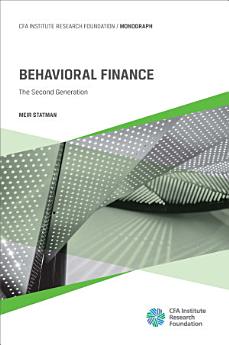Behavioral Finance: The Second Generation
ທ.ວ. 2019 · CFA Institute Research Foundation
5,0star
2 ຄຳຕິຊົມreport
ປຶ້ມອີບຸກ
246
ໜ້າ
family_home
ມີສິດ
info
reportບໍ່ໄດ້ຢັ້ງຢືນການຈັດອັນດັບ ແລະ ຄຳຕິຊົມ ສຶກສາເພີ່ມເຕີມ
ກ່ຽວກັບປຶ້ມ e-book ນີ້
Behavioral finance presented in this book is the second-generation of behavioral finance. The first generation, starting in the early 1980s, largely accepted standard finance’s notion of people’s wants as “rational” wants—restricted to the utilitarian benefits of high returns and low risk. That first generation commonly described people as “irrational”—succumbing to cognitive and emotional errors and misled on their way to their rational wants. The second generation describes people as normal. It begins by acknowledging the full range of people’s normal wants and their benefits—utilitarian, expressive, and emotional—distinguishes normal wants from errors, and offers guidance on using shortcuts and avoiding errors on the way to satisfying normal wants. People’s normal wants include financial security, nurturing children and families, gaining high social status, and staying true to values. People’s normal wants, even more than their cognitive and emotional shortcuts and errors, underlie answers to important questions of finance, including saving and spending, portfolio construction, asset pricing, and market efficiency.
ການຈັດອັນດັບ ແລະ ຄຳຕິຊົມ
5,0
2 ຄຳຕິຊົມ
ໃຫ້ຄະແນນ e-book ນີ້
ບອກພວກເຮົາວ່າທ່ານຄິດແນວໃດ.
ອ່ານຂໍ້ມູນຂ່າວສານ
ສະມາດໂຟນ ແລະ ແທັບເລັດ
ຕິດຕັ້ງ ແອັບ Google Play Books ສຳລັບ Android ແລະ iPad/iPhone. ມັນຊິ້ງຂໍ້ມູນໂດຍອັດຕະໂນມັດກັບບັນຊີຂອງທ່ານ ແລະ ອະນຸຍາດໃຫ້ທ່ານອ່ານທາງອອນລາຍ ຫຼື ແບບອອບລາຍໄດ້ ບໍ່ວ່າທ່ານຈະຢູ່ໃສ.
ແລັບທັອບ ແລະ ຄອມພິວເຕີ
ທ່ານສາມາດຟັງປຶ້ມສຽງທີ່ຊື້ໃນ Google Play ໂດຍໃຊ້ໂປຣແກຣມທ່ອງເວັບຂອງຄອມພິວເຕີຂອງທ່ານໄດ້.
eReaders ແລະອຸປະກອນອື່ນໆ
ເພື່ອອ່ານໃນອຸປະກອນ e-ink ເຊັ່ນ: Kobo eReader, ທ່ານຈຳເປັນຕ້ອງດາວໂຫຼດໄຟລ໌ ແລະ ໂອນຍ້າຍມັນໄປໃສ່ອຸປະກອນຂອງທ່ານກ່ອນ. ປະຕິບັດຕາມຄຳແນະນຳລະອຽດຂອງ ສູນຊ່ວຍເຫຼືອ ເພື່ອໂອນຍ້າຍໄຟລ໌ໄໃສ່ eReader ທີ່ຮອງຮັບ.






